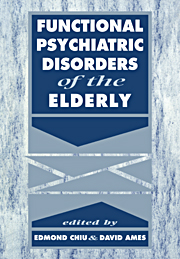Book contents
- Frontmatter
- Contents
- List of contributors
- Preface
- Introduction – A personal note
- Acknowledgement
- Part 1 Classification
- Part 2 General epidemiology
- Part 3 Neuroses
- Part 4 Affective disorders
- Part 5 Psychosexual disorders
- Part 6 Substance use and abuse
- Part 7 Schizophrenia and related psychoses
- Part 8 Psychological, biological and medical issues
- Part 9 Treatment methods
- 25 Geriatric psychopharmacology
- 26 Electroconvulsive therapy in later life
- 27 Family therapy
- 28 Group therapy in the elderly
- 29 Integrated psychotherapy of the elderly
- 30 Management of the treatment team in a multidisciplinary framework
- 31 Occupational therapy
- 32 Nursing management
- 33 Social work and the psychiatry of late life
- 34 Music therapy
- 35 Physiotherapy
- Part 10 Conclusion
- Index
29 - Integrated psychotherapy of the elderly
from Part 9 - Treatment methods
Published online by Cambridge University Press: 13 November 2009
- Frontmatter
- Contents
- List of contributors
- Preface
- Introduction – A personal note
- Acknowledgement
- Part 1 Classification
- Part 2 General epidemiology
- Part 3 Neuroses
- Part 4 Affective disorders
- Part 5 Psychosexual disorders
- Part 6 Substance use and abuse
- Part 7 Schizophrenia and related psychoses
- Part 8 Psychological, biological and medical issues
- Part 9 Treatment methods
- 25 Geriatric psychopharmacology
- 26 Electroconvulsive therapy in later life
- 27 Family therapy
- 28 Group therapy in the elderly
- 29 Integrated psychotherapy of the elderly
- 30 Management of the treatment team in a multidisciplinary framework
- 31 Occupational therapy
- 32 Nursing management
- 33 Social work and the psychiatry of late life
- 34 Music therapy
- 35 Physiotherapy
- Part 10 Conclusion
- Index
Summary
Introduction
Psychotherapy for the elderly is a rich but all too infrequently utilized modality of treatment. The data on efficacy and descriptions of technique reveal the depth and flexibility of approaches including cognitive therapies especially for depression and anxiety disorders (Thompson et al, 1991), psychotherapy in the institution (Sadavoy, 1992; Goldfarb & Turner, 1953), psychoanalytic psychotherapy (Rechtschaffen, 1959) psychoanalysis (Meerloo, 1953), and interpersonal psychotherapy (Scholomskas et al., 1983).
Elderly patients arrive at treatment on a variety of pathways either through selfreferral or, perhaps more commonly, because the individual is brought by his or her family. Frequently, the first contact is with a caregiver in the community such as a general practitioner or social worker. This initial contact offers a special opportunity for psychotherapeutic intervention, because the older person may accept more easily the medical context of the general practitioner's office or the service context of the social worker's office as opposed to the psychiatric context. Geriatric patients often feel that they will be branded as ‘crazy’ if they see a psychiatrist (Lazarus & Sadavoy, 1991) and frequently they are frightened of the meaning of the referral. The practitioner's awareness of the potential efficacy of these treatments is important since the elderly tend substantially to underutilize psychiatric outpatient services, not only because of their own shame and embarrassment, but equally because of practical problems in arranging transportation, the presence of comorbid medical conditions which may interfere with therapy, and scepticism about such treatment by too-narrowly focused practitioners.
- Type
- Chapter
- Information
- Functional Psychiatric Disorders of the Elderly , pp. 499 - 517Publisher: Cambridge University PressPrint publication year: 1994
- 1
- Cited by

